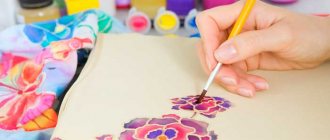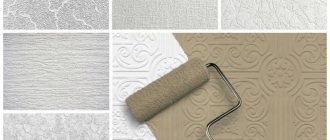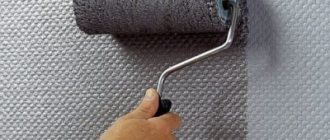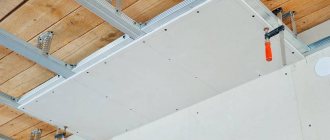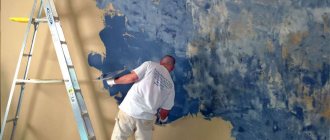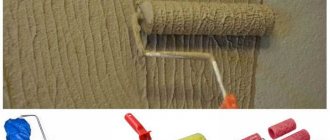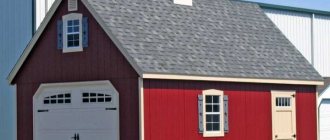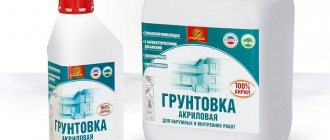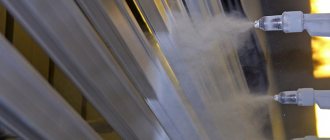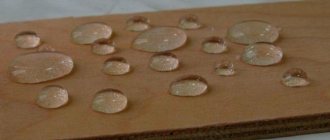0
02.05.2018
To know how to properly use water-based paint for walls, you should familiarize yourself not only with the application technology, but also with the procedure for preparing the surfaces to be decorated - all this is discussed in this article.
Water-based or water-dispersion paint is a water-based finishing coating with the addition of polymers that shape the properties of the material. Differences from other paints in the form of easy and quick application, variety of shades, and varying degrees of resistance make it universal for interior and exterior work.
Water-based paint for walls: characteristics
Technical characteristics of the paint: composition, consumption, viscosity, drying time - vary depending on the intended use.
By correctly comparing the desired parameters of coverage, finish gloss or dullness, and coating strength, you can choose a paint that suits all points.
Water-based emulsion has a number of advantages that distinguish it from other paints:
- drying time from 2 hours;
- lack of specific odor;
- environmental friendliness (safety for humans and the environment);
- the ability to choose the desired shades;
- easy cleaning of instruments and skin swabs
Painting with water-based emulsion should only be carried out at temperatures above 5°.
Varieties
Water-based paints are distinguished by the main polymer they contain:
- Acrylic. Acrylic resins make the paint durable and suitable even for external finishing work. It is used for wood, glass, brick, concrete, plastered and even primed metal surfaces. Acrylic water-dispersion compositions often contain an additional component - latex, which increases the water-repellent properties of the painted surface. A double layer is able to close microcracks on the wall (1 mm).
- Silicone. Silicone resins are a reliable basis for paints and varnishes for wet rooms. Silicone is an elastic material. Able to paint over larger cracks. The antiseptic present in the composition fights the formation of fungus and mold. The composition is suitable for bathrooms, kitchens, including painting ceilings with protection from moisture, steam, and temperature changes.
- Silicate. Paint based on liquid glass is more often used for façade finishing due to its increased resistance to weather conditions. The durability of silicate coating reaches 20 years. The peculiarity of the coating is transparency, so it is rarely used in interiors due to low hiding power and a small range of shades. The presence of mica, talc, and silicon in the composition makes tinting impossible, so the choice of color is limited.
- Mineral. Suitable for painting concrete, brick, cement surfaces. The paint is designed to protect against water and ultraviolet radiation and requires regular renewal of the layer. The fragility of the coating makes mineral water-based emulsion a rarely chosen but cheap option not for cosmetic repairs.
GOST water-dispersion paint and varnish materials
GOST tables of water-dispersion paints and varnishes:
Table 1. Technological indicators of coatings and methods for their determination.
| Indicator name | Test method |
| 1 Conditional viscosity at temperature (20 ± 2) °С according to the VZ-246 viscometer, s | By Paint and varnish materials. Methods for determining conditional viscosity GOST 8420 |
| 2 Mass fraction of non-volatile substances, % | According to GOST 17537 |
| 3 Drying time to degree 3 at temperature (20 ± 2) °C, h | By Paint and varnish materials. Method for determining the time and degree of drying GOST 19007 |
| 4 pH (for water-dispersion paints) | By >Water-dispersion paint and varnish materials. General technical conditions GOST R 52020 |
| 5 Frost resistance, cycles | By >Water-dispersion paint and varnish materials. General technical conditions GOST R 52020, clause 9.8 |
| 6 Flash point in a closed crucible (for solvent-soluble coatings) | According to SSBT. Fire and explosion hazard of substances and materials. Nomenclature of indicators and methods for their determination GOST 12.1.044 |
Table 2. Indicators of consumer and performance properties of coatings based on paints and enamels intended for interior work must meet the requirements.
| Indicator name | Indicator value | Test method | ||
| Paints | Enamels | |||
| water-dispersed | oil | |||
| 1 Appearance | By >Water-dispersion paint and varnish materials. General technical conditions GOST R 52020 | Oil paints, ready for use. General technical conditions GOST 30884 | By Paint and varnish materials. Enamels. General technical conditions GOST R 51691 | By >Water-dispersion paint and varnish materials. General technical conditions GOST R 52020, clause 9.3; Oil paints, ready for use. General technical conditions GOST 30884, clause 9.3; Paint and varnish materials. Enamels. General technical conditions GOST R 51691, clause 9.3. According to regulatory or technical documents for a specific paintwork material |
| 2 Covering capacity of the dried film, g/m2, no more | 120 | 150 | 120 | According to GOST 8784, method 1 |
| 3 Adhesion, points, no more | — | — | 1 | By Paint and varnish materials. Methods for determining adhesion GOST 15140, section 2 |
| 4 Film elasticity when bending, mm, no more | — | — | 1 | By Paint and varnish materials. Method for determining the elasticity of film during bending GOST 6806 |
| 5 Impact strength on device U-1, cm, not less | — | — | 50 | By Paint and varnish materials. Method for determining impact strength GOST 4765 |
| 6 Hardness according to a pendulum device type TML, rel. units, no less | — | — | 0,15 | According to GOST 5233 |
| 7 Conditional light fastness, h, not less | 12 (for colored paints) | 2 (for colored paints) | 2 | According to GOST 21903 |
| 8 Static resistance: | According to GOST 9.403, method A | |||
| — water at a temperature of (20 ± 2) °С, h, not less | 24 | 1 | 10 | |
| — detergent solution at a temperature of (38 ± 2) °C, min, not less | — | — | 15 | |
| 9 Film washability, g/m2, no more | 3,5 | — | >- | By >Water-dispersion paint and varnish materials. General technical conditions GOST R 52020 |
| 10 Predicted service life under operating conditions U2, U3, HL2, UHL2, HL3, UHL3, years, not less | 6 | 2 | 6 | According to ESZKS. Paint and varnish coatings. General requirements and methods of accelerated testing for resistance to climatic factors GOST 9.401, Appendix 10 |
Table 3. Indicators of consumer and operational properties of primers and coatings based on them, intended for interior work, must meet the requirements.
| Indicator name | Indicator value for varnishes | Test method | |
| 1 Drying time to degree 3 at temperature (20 ± 2) °C, h, no more | 24 | 12 | By Paint and varnish materials. Method for determining the time and degree of drying GOST 19007 |
| 2 Coating adhesion, points, no more | 1 | — | By Paint and varnish materials. Methods for determining adhesion GOST 15140, section 2 |
| 3 Resistance of the coating to the static effects of water at a temperature of (20 ± 2) °C, h, not less | 24 | 24 | According to GOST 9.403, method A |
Table 4. Indicators of consumer and operational properties of putties and coatings based on them must meet the requirements.
| Indicator name | Indicator value | Test method |
| 1 Drying time to degree 3 at temperature (20 + 2) °C, h, no more | 24 | By Paint and varnish materials. Method for determining the time and degree of drying GOST 19007 |
| 2 Portability | The putty should be easy to apply, not curl up or drag on the tool. | According to regulatory or technical documents for a specific paintwork material |
| 3 Sandability | When sanding, a smooth surface should be formed. | According to regulatory or technical documents for a specific paintwork material |
| 4 Strength of adhesion to the surface, MPa, not less than: | On Corrosion protection in construction. Concrete and reinforced concrete structures. Test methods for adhesion of protective coatings GOST 28574 | |
| — after 24 hours | 0,2 | |
| - after 72 hours | 0,6 |
TOP 5 rating of popular water-based paints: which is better
Manufacturer country | pros | Minuses | |
| Tikkurila | Finland | · Optimal combination of price and quality. · Modern production technologies. · Constant expansion of the range with new products for different surfaces. · Unpretentiousness in everyday life (vapor permeability, dirt-repellent properties, etc.). · Hypoallergenic. | · The need for professional tinting. · Price. · The need for combination with other finishing materials of the same brand. |
| Ceresit | Russia | · High adhesion (adhesion to the surface). · Resistance to direct sunlight. · Uniformity of painting and tinting. | · High cost for double application required on any surface. |
| Dulux | Great Britain | · Environmentally friendly, making the paint an ideal option for bedrooms and children's rooms. · Constant modernization of technologies, confirmed by international exhibitions and competitions. · Durability of the coating. | · High price. · Many nuances of application, which requires the involvement of a professional in painting. |
| Caparol | Germany | · A network of factories around the world. · Affordable price. · High resistance to washing and abrasion. · High hiding power (one layer is enough). | · Complete drying takes several days. |
| Dufa | Germany | · Wide range of shades and textures. · High quality compositions. | · Poor coverage and strength of the coating. · Absence of a snow-white shade in the palette (often chosen for the ceiling). |
Recommendations for application
Carrying out work indoors does not impose particularly strict requirements on the microclimate - above-zero temperatures and low humidity (below 80%) are sufficient.
When doing facade work, you will need to study the weather forecast in advance and choose a good day for the procedure. The indicated requirements for temperature and humidity remain, but new ones are added to them: it should not be too hot and sunny outside (otherwise cracks or stains may appear). At the same time, there should be no precipitation, even small ones, for at least the next two days: if the paint has not had time to dry, it will wash it off; if it has, the coating will still be less reliable.
Valera
The voice of the construction guru
Ask a Question
Since dispersion paint is somewhat inferior in coverage to water-based paint, it produces higher consumption. On average it is about 300 ml per 1 m². On the other hand, this paint does not require purchasing a solvent: it is diluted with plain water, so the consumer saves on this component.
Tools and materials
If the master has a spray gun , he can use it to work with dispersion compositions. This is the most convenient and fastest method of application. If this device is not available, use standard tools :
- brushes of different widths;
- roller;
- a cuvette for removing excess paint from the roller;
- masking tape, plastic, or disassembled cardboard boxes to protect floors, baseboards, and other areas that should not be exposed to paint.
Scotch tape can also be used for zone painting of a room. It helps separate one area from another.
Preparatory work
Since the coating is thin, the walls must be well leveled . If there are no defects on them, it is enough to wipe them with a damp cloth to remove dust and dirt and dry them.
Uneven walls with peeling old paint require thorough preparation. The top coating is removed, then the walls are vacuumed and leveled with putty. If necessary, apply it several times, sanding after each approach. Before painting, the wall is primed.
Applying paint
The composition must be stirred before application. First they work with brushes : they paint the corners and areas adjacent to them (wide) and hard-to-reach places such as areas around sockets (narrow). Then the mixture is taken into a cuvette , the roller is saturated and the excess is squeezed out. The tool is worked from top to bottom.
If the ceiling is painted , the last layer (regardless of the total number) should be located at right angles to the wall with the window opening. Then darkening and other defects will not be visible on the surface.
Useful tips
Dispersion paint is suitable for wood: it repels water, preventing the material from rotting and molding, while allowing it to “breathe”. However, it causes the fibers to “stand on end”, increasing the surface roughness. This effect can be removed by sanding. It is carried out several times - before painting and after applying each layer. Then the product will look neat.
After finishing work, tools should not be washed with organic solvents, otherwise the polymer components will coagulate and lumps will accumulate between the fibers.
The paint should be stored at a positive temperature (+5...+30 degrees).
It should not be kept near heating radiators. Some formulations can be kept at low temperatures for a short time (no more than a month). The manufacturer warns about this possibility on the packaging.
Painting
Walls are painted in three layers: the first is primer, the next two are paint and varnish.
Painting is carried out in stripes overlapping each other at the junction in the manner of writing the letter “W”.
It is better to start work in daylight in the direction from the window in the opposite direction.
How to prepare a wall for painting
The preliminary stage includes plastering the uneven walls, then applying a layer of putty. After the materials have dried, the walls are washed with soapy water and a layer of primer is applied.
Popular Technologies
There are three main technologies for painting walls:
- brush;
- roller;
- spray gun.
Brush painting is an energy-intensive process with less than ideal results.
The brush applies the paint unevenly and leaves streaks. However, you cannot do without a brush when processing areas in corners, at the joints with the ceiling, and around window frames. To do this, you need to choose a brush 10-15 cm wide, immerse it in liquid up to a third of the bristles, and use a mesh to get rid of excess on the brush. Painting with a roller is a quick method that requires care in distributing the paint, first on the roller itself, then on the wall to avoid drips and splashes. To do this, use a special tray with a container for water emulsion and a place for rolling.
The use of a spray gun gives a high-quality layer without streaks, omissions, smudges, or color differences. The device is characterized by a large simultaneous coverage of the wall area, which speeds up the painting process.
How to paint over old paint
It is possible to update the interior without bothering to remove the old coating only if the old paint does not peel off. For a new coating with water-based emulsion, you need to sand the wall, apply a primer layer, and then start painting.
If the old paint is covered with cracks, chips, or peeling places, then for better adhesion of the new coating it must be removed. The water-dispersion coating can be washed off with a special solvent, or mechanically using a spatula, chisel, grinder, hair dryer, etc.
How to apply to different surfaces
You can paint wallpaper, textured plaster, plasterboard structures, and old finishes with oil paint with a water-dispersion emulsion. Each of these cases requires an individual solution.
You can paint wallpaper that is specially marked “for painting”!
Others may behave unpredictably under the coloring composition - get wet, change the degree of smoothness of the surface, peel off from the wall, absorb the paint unevenly, creating streaks.
Plasterboard walls are becoming more popular due to the variety of shapes they can create and their smooth surface.
This simplifies the process of wallpapering, but painting requires a number of manipulations.
Painting of drywall is possible when applied to a layer of finishing putty. The layer of putty here can be minimal, since it is intended not to level, but to create a uniform surface without seams and putty at the joints to obtain a uniform color in just one layer of paint.
You should not apply water-based emulsion to whitewashed surfaces - it is better to wash off the whitewash first. Chalk or lime compounds will begin to crack and peel under the paint, forcing you to repaint the walls once a year.
Why use water-based emulsion?
In an apartment, office, or technological room, painting walls with water-based paint yourself is often the best option for many reasons.
The composition, prepared on the basis of a water-based emulsion, does not fill the room with unpleasant fumes during painting work.
The matte soft texture is in demand in the design of children's rooms, high-tech and minimalist styles.
Decor with water-based paint
The technology of painting walls with water-based paint allows you to easily change color saturation and create individual designs and patterns without using dissimilar materials. An example of changing tones of the same color is visible in the photo:
Often this method of creating contrasting transitions of tones is used if the wall being decorated has some irreparable irregularities.
The high coefficient of moisture permeability of water-based paint allows it to be used to cover walls in rooms with high humidity levels if the surface is properly prepared.
With a minimum expenditure of effort and money, these compounds can simply whitewash the ceilings and walls of technological and utility rooms.
How to choose colors
The selection of a color scheme for a room is often based on the warmth/coldness of the room. When the windows face south, the room is visually cooled by shades of blue, purple, and green. If the room is located on the north side, then warm shades of yellow, red, and brown are better suited.
Wall surface type
Water-based coating is used for wooden, concrete, and brick surfaces. Apply to walls, ceilings, plaster and drywall. Regardless of the type of surface, an important factor in achieving an ideal result is thorough mixing of the emulsion. In addition, it is worth paying attention to the recommendations in the instructions for the paint: for example, if a water-based emulsion requires dilution with water, then it is better not to neglect this manipulation for uniform coverage.
Number of colors
The standard layout for a room is a palette of three shades. The variety of modern colors allows you to choose a range of colors of the desired brightness or pastel, as well as visually change the feeling of space in the room. So, light colors expand the space, dark ones narrow it. This technique can be used in combination to visually raise the height of the room when choosing dark walls and a light ceiling.
Processing degree
The degree of pre-treatment determines the subsequent adhesion of the paint and the wall.
If insufficiently processed, the water-based emulsion will hold up worse. If the absorbency of the wall surface is incorrectly calculated, painting may require more materials.
The degree of processing must be calculated in advance, since the volume of paint to be tinted depends on it.
Main operating parameters
The main operational parameters include color, appearance of the surface after application, the proportion of resin content, and additional components.
Main paint properties and technical characteristics:
- after application and hardening, a homogeneous film with a smooth surface is formed;
- the selected shade will be similar to the sample in the catalog;
- slightly alkaline composition;
- titanium dioxide is added to the composition;
- drying speed in warm weather – 60 minutes;
- After complete drying, the surface of the walls and ceilings can be washed.
The properties of the paint include its resistance to frost. It refers to the number of freezing cycles that the coating can withstand under standard conditions. Additional parameters are drying speed, resistance to light and mechanical damage.
How to paint without streaks
It is preferable to paint the wall in 2 or 3 thin layers than in 1 thick layer that forms streaks. In addition, it is better to apply a new layer of paint on top of the completely dried previous one.
Applying the emulsion in thin layers helps to avoid streaks!
White water emulsion
White water-dispersed paint is usually mixed with a special conditioner thinner. This additive gives the paint additional time to dry so that the joints of the painted areas can be covered without creating overlap marks.
Colored wall paint
A tinted primer - matching the color of the paint or a suitable shade - helps to avoid streaks on a colored coating and make it richer. Also, a colored primer allows you to achieve the desired color in fewer layers.
Advantages and disadvantages
Water-dispersion paint for walls and ceilings, for wood and radiators, for interior and exterior work has many advantages. Here are some of them:
- Absolute safety and environmental friendliness. This is achieved due to the fact that ordinary water is used as a solvent.
- No unpleasant odors.
- Easy to use. It is not necessary to have any special skills in order to paint a surface. For application you can use a brush or roller.
- Such paints are not flammable. This explains their fire safety.
- Mold and mildew do not appear on the surface. This is evidence that the coating “breathes”.
- The service life of the coating is approximately 15 years. At the same time, it will not peel, crack or swell.
- It only takes a couple of hours for one coat of paint to dry completely.
- The coating is resistant to mechanical damage.
- Affordable price.
- Excellent moisture resistance. This is especially good for wood surfaces. The film created by the paint will provide reliable protection.
- Has a certificate of compliance with all necessary requirements.
Despite all the advantages, such dyes also have several disadvantages:
- The quality of coverage depends on the weather. It is not recommended to carry out work during rainfall or cold weather. If it rains, the solvent (water) simply will not evaporate. There is no need to work in the heat either. The surface will dry out too quickly, degrading the quality of the coating.
- The working surface must be prepared. It is important that it is perfectly even. A thin layer of dye will not hide imperfections.
- The price may be higher than that of paints that use other solvents.
Tips and tricks
The first step towards an even paint coating on a surface is the choice of tools (rollers, brushes, rolling trays, painting nets for removing excess paint).
It is not difficult to distribute the composition over a roller or brush; the main thing is to act smoothly, slowly: roll the roller several times on a flat surface, and put only the required amount of paint on the brush. An important point when applying the final layer of paint is taking into account the direction of the light rays. The coincidence of the planes of incidence of light and the painting of the finishing layer makes it possible to hide the heterogeneity of both the structure of the wall and the painted surface.
In addition, it is important to calculate the amount of paint that will be needed, preferably with a reserve, since when tinting it is impossible to achieve a repeat result that matches the first portion of paint.
Thus, painting walls with water-based paint has a number of advantages in the form of environmental friendliness, ease of application, a wide color palette and a large selection of types of paints for different surfaces.
Preparing the walls
The wall is thoroughly cleaned, paint, wallpaper, and crumbling plaster are removed. Cleaning is carried out from fungi, mold, dirt, traces of grease, etc. Places where fungi were found are treated with impregnation with antibacterial properties.
The walls are carefully leveled with plaster, then covered with moisture-resistant putty. After the putty has dried, the surface is sanded until a smooth, even result is obtained.
A primer layer is applied to the resulting smooth wall. Use masking tape to cover areas that should avoid paint contact.

